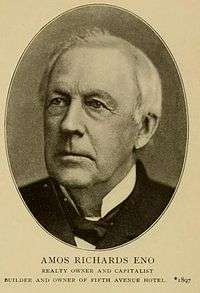Amos Eno
Amos Richards Eno (November 1, 1810 – February 21, 1898) was an American real estate investor and capitalist in New York City. He built the Fifth Avenue Hotel and many other developments on the streets of Broadway and Fifth Avenue, where he established a prominent family fortune of 20 to 40 million U.S dollars.[1]

Early life
Amos Richards Eno was born November 1, 1810, in Simsbury, Connecticut.
Business ventures
Amos R. Eno began his career as a merchant of dry goods who expanded into real estate in New York City having built the Fifth Avenue Hotel in New York City and much valuable real estate in New York City where he established a prominent family fortune. Having clerked in a small general store in Hartford, Connecticut, he married Lucy Phelps, also of Simsbury, and moved to New York, where he and his cousin John Jay Phelps opened a profitable dry goods business. While making a fortune in the dry goods business, Amos Eno parlayed his profits into real estate investment in Manhattan, New York, buying corner lots and occasionally full undeveloped city blocks.[1]
His brownstone-fronted store at 74 Broadway had the reputation of having been the first use of brownstone in the city.[1] Retiring from active participation as a merchant, he concentrated in 1856–59 in building the famous Fifth Avenue Hotel at the corner of Fifth Avenue and 23rd Street in Madison Square, Manhattan, and the adjacent Madison Square Theatre in 1863.
North of Madison Square, Eno built a brick four-storey house at 233 Fifth Avenue, between 26th and 27th Streets, that served as his residence for many years. In April 1890, Eno sold it to The Reform Club for $240,000 (equivalent to $6,829,333 in 2019).[1] Anson Phelps Stokes was in 1888 its founding president. Before moving into Eno's mansion, the club had been located at 12 East 33rd Street.[2] The structure at 233 Fifth Avenue, still much in its original form, currently is the home of the Museum of Sex.
Eno and relatives, in April 1882, chartered the Second National Bank of New York, headquartered in the hotel. In 1884 scandal hit the family bank when one of Amos' sons, John Chester Eno, president of the bank, embezzled millions of dollars and then fled to Canada to avoid prosecution. Eno never closed the bank, though three to four million dollars were withdrawn in panic, and made good his son's embezzlement, "though he never recovered from the shock".[1] He held the greater part of a full block facing Broadway in Longacre Square (now Times Square). His last real estate speculations were in open lots in the Upper West Side.
Retirement
After settling his son's debts, Amos retreated to the family summer residence in Simsbury, the Amos Eno House (1820, on the National Register of Historic Places) which had been erected by Eno's father-in-law, Elisha Phelps. Every summer the Eno family would visit the house, which was enlarged by Eno and by his daughter Antoinette Eno Wood. He was a founding benefactor of the Simsbury Free Library, among other local philanthropic gestures.
Death and estate
Amos R. Eno died February 21, 1898. At time of his death his wealth was evaluated from 20 to 40 million dollars.
Notes
Eno's portrait by Eastman Johnson, commissioned by his family in 1899, was a posthumous one, based on photographs; it is conserved in the New York State Museum.[3]
Marriage and family
Amos Richards Eno – on January 14, 1835, in Simsbury, Connecticut – married Lucy Jane Phelps (maiden; 1818–1882), daughter of Elisha Phelps (1779–1847). Their children included:
- Amos F. Eno (1836–1915); never married and left his entire estate to Columbia University
- Mary Jane Eno (1838–1914); married to James Wallace Pinchot (1831–1908); whose children included:
- Gifford Pinchot (1865–1946);
- Amos Pinchot (1873–1944), an American reformist, a mainstay and the historian of the Progressive Party, 1912–1916; he married, in 1900, Gertrude Minturn (1872–1939), daughter of shipping magnate, Robert Bowne Minturn, Jr. (1836–1889); Amos Pinchot divorced Gertrude in 1918; their daughter, Rosamond Pinchot (1904–1938), an actress, shocked the world when she committed suicide; Rosamond had been married to William Alexander "Big Bill" Gaston (1896–1970), a grandson of William Gaston (1820–1894), the 29th Governor of Massachusetts;
- Antoinette Eno Pinchot (1869–1934); married to Alan Johnstone GCVO (1858–1932); whose son was:
- Harcourt Johnstone (1895–1945)
- William Phelps Eno (1858–1945), the father of road safety in America;
- Henry Clay Eno (1840–1914), father of Henry Lane Eno (1871–1928);
- John Chester Eno (1848–1914), who, in 1879, got caught in a scandal by embezzling about 4 million US dollars from the Second National Bank of New York, of which he was president, causing a run on the bank, all of which was covered by his father, Amos, Isaac Noah Phelps, and William Walter Phelps;[4][5] and
- Antoinette Eno (1842–1930); married to Charles Boughton Wood (1822–1889)
References
- "Amos R. Eno's Life Ended" (obituary), The New York Times, February 22, 1898Note: address misprinted as "23 Fifth Avenue"
- "Madison Square North Historic District Designation Report," New York City Landmarks Preservation Commission, June 26, 2001, p. 14; OCLC 47801491
- New York State Museum: Portrait of Amos R. Eno Archived May 23, 2011, at the Library of Congress Web Archives
- A Treatise of Extradition and Interstate Rendition (Vol. 1 of 2), by John Bassett Moore, The Boston Book Company (1891), p. 660; OCLC 892231199
- [Uncle Sam’s Policemen] by Katherine Unterman, Harvard University Press (2015); OCLC 1091483542, 1058858763